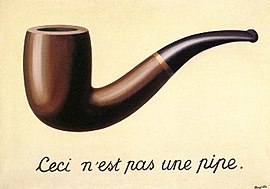The Treachery of Images
| The Treachery of Images | |
|---|---|
 | |
| Artist | René Magritte |
| Year | 1929 |
| Medium | Oil on canvas |
| Movement | Surrealism |
| Dimensions | 60.33 cm × 81.12 cm (23.75 in × 31.94 in) |
| Location | Los Angeles County Museum of Art[1] |
The Treachery of Images (French: La Trahison des Images) is a 1929 painting by Belgian surrealist painter René Magritte. It is also known as This Is Not a Pipe,[2] Ceci n'est pas une pipe[2] and The Wind and the Song.[3] It is on display at the Los Angeles County Museum of Art.[1]
The painting shows an image of a pipe. Below it, Magritte painted, "Ceci n'est pas une pipe" (pronounced [sə.si ne paz‿yn pip], French for "This is not a pipe".)
The famous pipe. How people reproached me for it! And yet, could you stuff my pipe? No, it's just a representation, is it not? So if I had written on my picture "This is a pipe", I'd have been lying!
— René Magritte[4]
The theme of pipes with the text "Ceci n'est pas une pipe" is extended in Les Mots et Les Images,[5] La Clé des Songes,[6] Ceci n'est pas une pipe (L'air et la chanson),[7] The Tune and Also the Words,[8] Ceci n’est pas une pomme,[9] and Les Deux Mystères.[10]
The painting is sometimes given as an example of meta message[11] like the Alfred Korzybski's "The word is not the thing" and "The map is not the territory", as well as Denis Diderot's This is not a story.
On December 15, 1929, Paul Éluard and André Breton published an essay about poetry in La Révolution surréaliste (The Surrealist Revolution) as a reaction to the publication by poet Paul Valéry "Notes sur la poésie" in Les Nouvelles littéraires of September 28, 1929. When Valéry wrote "Poetry is a survival", Breton and Éluard made fun of it and wrote "Poetry is a pipe", as a reference to Magritte's painting.[12][13]
In the same edition of La Révolution surréaliste, Magritte published "Les mots et les images" (his founding text which illustrated where words play with images), his answer to the survey on love, and Je ne vois pas la [femme] cachée dans la forêt, a painting tableau surrounded by photos of sixteen surrealists with their eyes closed, including Magritte himself.
See also
[edit]- List of paintings by René Magritte
- Direct and indirect realism – Debate in the philosophy of mind
- Self-reference – Sentence, idea or formula that refers to itself
- Simulacra and Simulation – 1981 book by Jean Baudrillard
- Subtext – Aspect of communication that is not explicitly announced
- Theory of forms – Philosophical theory attributed to Plato
References
[edit]- ^ a b La Trahison des images (Ceci n'est pas une pipe), Los Angeles County Museum of Art
- ^ a b Foucault, Michel (2008). This is Not a Pipe (PDF). James Harkness (Editor, Translator), René Magritte (Illustrator) (2nd ed.). Berkeley: University of California Press. ISBN 9780520236943.
- ^ Bowman, Russell (2014). "Words and Images: A Persistent Paradox". Art Journal. 45 (4): 335–343. doi:10.1080/00043249.1985.10792322. JSTOR 776809.
- ^ Torczyner, Harry (1977). Magritte: Ideas and Images. p. 71. ISBN 9780810913004.
- ^ "René Magritte - Les mots et les images". The Ideophone. 13 July 2013. Retrieved 25 July 2017.
- ^ "René Magritte - La Clé des Songes". Artnet. Retrieved 25 July 2017.
- ^ "René Magritte - Ceci n'est pas une pipe (L'air et le chanson)". Artnet. Retrieved 25 July 2017.
- ^ "René Magritte - L'air et le chanson". Art Institute Chicago. 1964. Retrieved 25 July 2017.
- ^ "René Magritte - Ceci n'est pas une pomme" (PDF). Retrieved 25 July 2017.
- ^ "René Magritte - The Two Mysteries". abcgallery.com. Retrieved 3 October 2010.
- ^ Haiman, John (2004). "Review of "Languages within language: An evolutive approach" by Ivan Fonagy". Studies in Language. 28: 246. doi:10.1075/sl.28.1.14hai.
- ^ "La revolution surrealiste" (PDF).
- ^ Zanchetti, Giorgio (2007). "Esploratori di parole". Esploratori di parole, in La parola nell'arte (in Italian). Milan: Skira. p. 26. doi:10.5281/zenodo.3597936. ISBN 978-88-613-0460-4.
Further reading
[edit]- Allmer, Patricia. René Magritte: Beyond Painting, Manchester University Press, 2009. ISBN 0719079284.
- Harkness, James, ed. Michel Foucault: This Is Not a Pipe, University of California Press, 2008. ISBN 0520236947.
External links
[edit]| External videos | |
|---|---|
- G.S. Evans (2005). "This could be a pipe: Foucault, irrealism and Ceci n'est pas une pipe". irreal (re)views.
